Tests & Results
Twisted Wire (In the Loop Itself) Test
Purpose:
– Observe and record if twisted loop wire has any different detection than untwisted loop wire.
– Dispel the myth that a twist in the loop wire will cancel the EMFs (Electromagnetic Fields) causing a reduction in loop detector performance.
Hypothesis:
“Canceling” of the EMF doesn’t exist in loop applications, therefore there will be no difference in loop performance if the loop wires are twisted or untwisted.
Whether the loop wires are twisted or untwisted, the EMF fields will be the same size as long as the wires are held tightly together (jacketed or twisted).
Twisting the wires in the loop itself has no effect on their EMFs, lead-in (pigtails) will be covered in another report.
Materials:
– 6’ x 12’ Untwisted saw-cut loop with 20’ untwisted lead-in, jacketed, 16AWG. (BD Loops part# SC 36-20) 64.0 µH
– 6’ x 12’ Twisted pair loop (7 twists per foot*) with 20’ twisted lead-in, jacketed, 16AWG. 64.1 µH
– EDI Detector Model#LMA-1250 Ser# 090600071 (detector has a Deflecto™ meter to show how much an object changes the inductance of a loop)
– T-Pins (to hold loop in place) Quantity: 4
– Drill with masonry bit (to drill holes for T-Pins)
– Chalk string (to mark vehicle travel path)
– Tape Measurer (to measure various distances)
– Inductance Meter, Model# Meterman LCR55 (to measure each loop to insure the loops are identical)
– Standard size vehicle – 08’ Kia Rio5
– Camera for documentation purposes
Procedure:
Testing area was prepared by measuring and marking a 6×12 loop footprint. Holes were drilled into the corners of the loop footprint and T-Pins were inserted. A BD Loops 6’ x 12’ (SC 36-20) preformed loop was then wrapped around the T-Pins. 16AWG, Jacketed twisted pair wire was then wrapped around the same T-Pins on top of the preformed loop (SC 36-20) to insure that a same sized twisted pair loop would be made (See Figure 3). The lead-in of the twisted pair loop was made to match the size of the preformed loop by measuring the lead-ins to be equal in length. A foot of the twisted pair loop’s jacket was cut back and the twists per foot were counted and pictured (See Figure 4). An Inductance meter was used on each loop to insure the two loops were identical and the meter readings were 64.0 µH on the untwisted loop (see Figure 1) and 64.1 µH on the twisted pair loop (See Figure 2). The meter was pictured for documentation purposes.
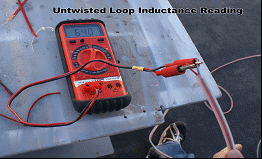
Inductance Reading of untwisted Loop 64.0 µH
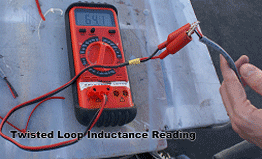
Inductance Reading of Twisted Pair Loop 64.1 µH

Twisted Pair and untwisted loop laying on top of one another

Inside of Twisted Pair (7 twists per foot)
The Kia was driven into position and lines were drawn using a chalk string to mark the vehicle’s travel path. BD Loops’ 6’ x12’ (SC 36-20) preformed loop was then wrapped around the T-Pins and connected to the EDI detector. The detector was reset and set to a sensitivity level of 1.
The Kia then drove perpendicular to the loop’s 12ft leg (See figure 5) and stopped at a set point so the Kia’s front tire would not drive over the loop’s leg, while the EDI detector was monitored for a detection. No detection occurred on sensitivity level of 1 and a “no detection” was recorded. The Kia reversed 99 inches until clear of the loop’s detection range (See figure 6). The sensitivity level was changed up one level at a time and the above process repeated until a detection occurred. A detection occurred on sensitivity level 3, with a Deflecto™ meter reading of 1. The above process was repeated at sensitivity levels 4-9 and the data recorded.
The BD Loop’s 6×12 (SC 36-20) preformed loop was then replaced with a 6’ x 12’ Twisted Pair loop (7 twists per foot) with 20’ twisted lead-in, Jacketed, 16AWG loop. The previous paragraph’s test procedure was repeated and its data recorded.
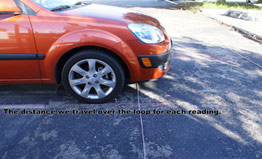
Kia driving perpendicular to the loop’s 12ft leg
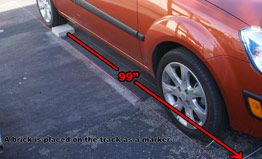
Distance from block to loop – 99″ as shown by red arrow
Results:
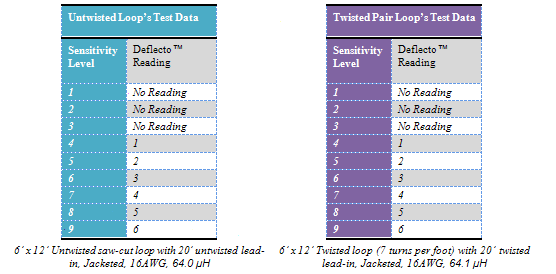
Results show regardless if the loop wires are twisted or untwisted detection is not affected. Furthermore, the test results show that no “canceling of the EMFs” (Electromagnetic Fields) are taking place.
Conclusion:
There is no difference in detection strength between twisted loop wire or untwisted loop wire.
There is no evidence that “canceling of the EMFs” (Electromagnetic Fields) are taking place in loop applications. Twisting of the loop wire itself has no effect on detector performance.
Whether the loop wires are twisted or untwisted, the EMF fields will be the same size as long as the wires are held tightly together (jacketed or twisted).
Twisting the wires has little to no effect on a loops EMF.
BD Loops – What these Results Mean for Installers
The twisting of the loop itself has no effect on the detection strength. What the installer needs to be aware of is that this myth is widespread throughout the industry. Don’t be misinformed while diagnosing a problem on your next loop system.
The purpose of twisting is to prevent movement of the wires and nothing else. Therefore it is important when installing loops to make sure the wires can’t move, this can easily be accomplished by installing a jacketed preformed loop. When wrapping loops by hand the wires can remain untwisted, but make sure the groove is 3/16” or wider (1/8” saw-cut groove will form air-pockets), Sealant fully encapsulates the wires, and backer rod is used every couple feet to prevent movement.
The advantages of using untwisted wires in BD Loops preformed saw-cut include not having to make a second cut to accommodate the wider twisted pair, use the same blade for both the loop and the lead-in, less sealant is required to seal the groove, and additional time is saved because you don’t have to twist the lead-in.
BD Loops
The Loop Experts!
BD Loops was founded in 2001. Their preformed loops and accessories are designed with the installer in mind. BD Loops offers a complete loop system solution including preformed direct burial loops, preformed saw-cut loops, loop sealant, blades, testing devices, and installation tools. BD Loops has a reputation for reliability and ease of installation. They pride themselves on the quality of their products and their commitment to providing excellent customer service and support. BD Loops preformed loops are made in the USA at their facility in Placentia, CA.

